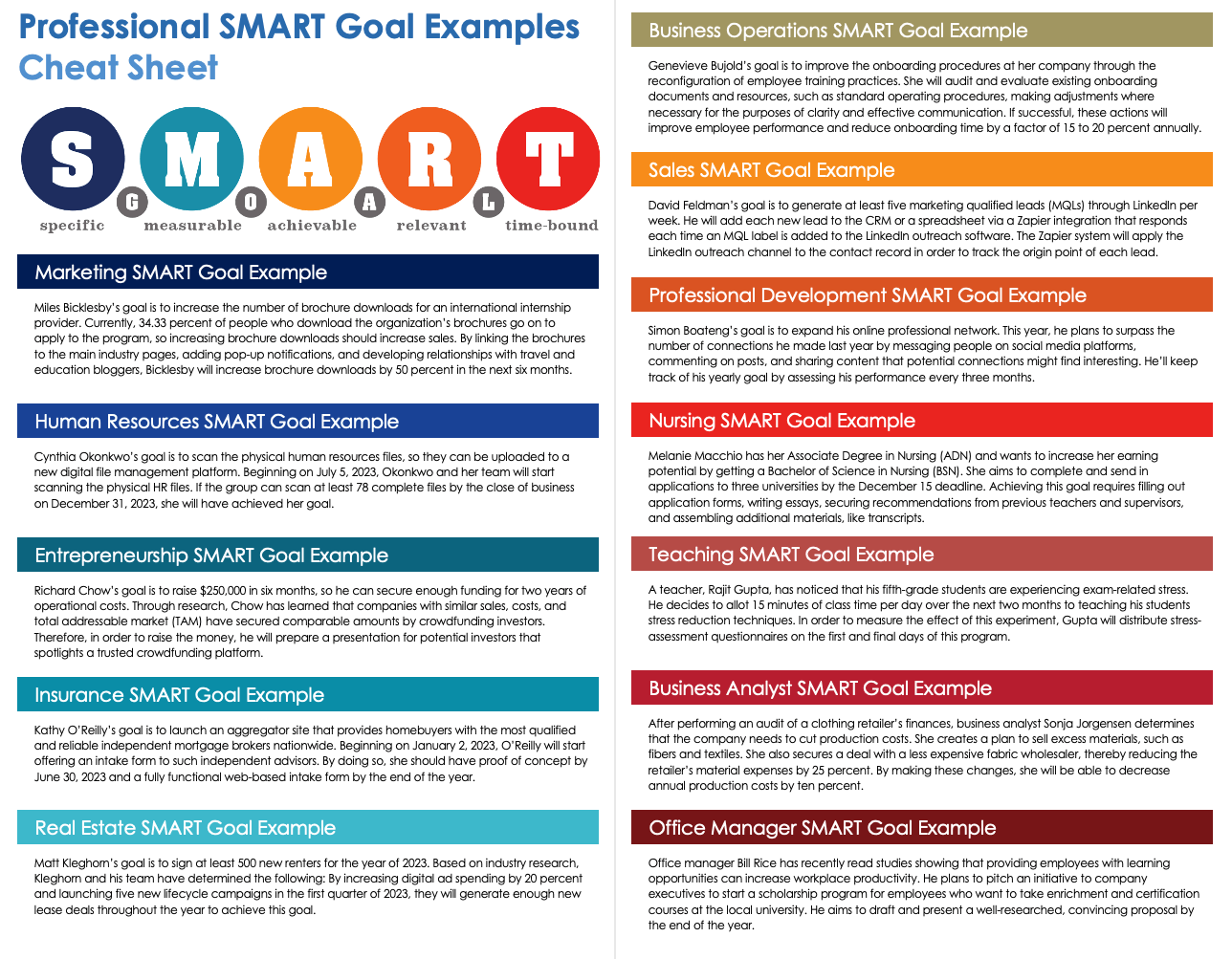What Are SMART Goals for Work?
SMART goals are statements that meet certain criteria. SMART is an acronym that stands for specific, measurable, achievable, relevant, and time-bound. Defining SMART goals makes success more likely. Use SMART goals at work to complete tasks and improve processes.
These are the criteria that all SMART goals for work need to meet:
- Specific: Think about the teams and people involved in a specific scenario. What is the goal you want to achieve, product you want to build, or process you want to improve? What actions will you take to meet that goal?
- Measurable: Goals should be quantifiable. Include percentage increases or decreases, product quantities, dollar amounts, process durations, or other numerical data that can measure success.
- Achievable: Consider your company’s available resources. Goals should be realistic, given your available team members, finances, technology, time, and other resources. Outcomes should not rely on external factors such as stock prices or weather. This criterion is sometimes called attainable.
- Relevant: Pick a goal that aligns with the vision for your company or department. Achieving this goal should move you closer toward larger organizational goals. Think about what makes this result important.
- Time-Bound: Set a specific timeframe within which you can achieve the goal. You can list this in days, weeks, months, or even years. This criterion is sometimes called trackable.
Professional Examples of SMART Goals
We’ve rounded up real-life examples of professional SMART goals. Learn how experts use SMART goals to hit targets and show work leadership. Find examples for various industries, departments, and work scenarios.
Marketing SMART Goal
Murray Dare is the founder of Murray Dare Marketing Consultancy. He describes a goal to distribute digital brochures for an international internship provider.
“We decided to set a goal to grow leads by increasing the number of brochure downloads by 50 percent in the next six months,” explains Dare. “Currently, 34.33 percent of people who download a brochure eventually go on to apply. We want to increase the clickthrough rates and, therefore, the sales.”
In order to meet this goal, Dare explains, his team would take several actions, such as linking the brochures on main industry pages, adding pop-up notifications, and developing relationships with travel and education bloggers. In addition, he says, “We started writing monthly newsletters to the existing mailing list and highlighting specific programs in each to push people to view the page and brochure.”
Here is how Dare’s marketing goal meets SMART goal criteria:
- Specific: Include download links on industry pages, add pop-up advertisements, and create backlinks on influencer websites — these were all specific actions his team took to meet its goal.
- Measurable: The team needs to see a 50 percent increase in brochure downloads in order to meet this goal.
- Achievable: Based on data and current clickthrough rates, a 50 percent increase should be attainable. “We were already receiving downloads organically without pushing or promoting the brochures,” Dare adds.
- Relevant: “Our data suggested that 34.33 percent, or just over one-third, of those downloading the brochure in 2022 so far went on to apply,” explains Dare. This goal will move the client closer to their larger goal of increasing admissions.
- Time-Bound: This goal needs to be completed within a six-month time frame, “which is our average sales funnel based on data,” Dare explains.
Human Resources SMART Goal
Cynthia Okonkwo is an assistant director for human resources at the University System of Georgia and runs a human resources blog. She describes a goal to scan the physical human resources files so they can be uploaded to a new digital file management platform.
She explains the process: “Beginning on July 5, 2022, the Atlanta HR team will resume scanning the remaining physical HR files in the HR file room. Each team member will work in alphabetical order, according to employees' respective last names, by selecting a file from the file cabinet each week, beginning with employees whose last names begin with the letter A. Each Atlanta office HR team member will scan at least one paper file, in its entirety, each week. Each team member will save the file that they scan to the HR confidential drive in File Explorer in the folder titled HR Paper File Scanning Project. The team member who completes a file scan will place a check mark beside the employee's name on the rolling checklist on the HR teams site to indicate scan completion. That same team member will place a red check mark on the scanned file folder and place it back in the file cabinet where they pulled it from.”
Here is how Okonkwo’s human resources plan meets SMART goal criteria:
- Specific: “The team knows exactly what they're to work on. The team also knows where their needed resources are located,” says Okonkwo.
- Measurable: Team members have a specific number of files they need to scan each week, and there is a consistent method for tracking how many scans they’ve completed.
- Achievable: “It is realistic and achievable given our workload,” Okonkwo says. She also built in slack time, saying, “If workload allows, team members can scan more than one file in a work week.” This would allow for even earlier completion.
- Relevant: “This goal is relevant to our new digital platform migration that we are currently testing,” she explains.
- Time-Bound: “With a three-member Atlanta team, we will achieve our goal if, at the close of business on December 31, 2022, we have completely scanned at least 78 files,” she shares.
Entrepreneurship SMART Goal
Richard Clews is the founder of pantsandsocks.com. He describes a goal to secure funding for his ecommerce company.
“I like the SMART framework, and we actually included some SMART goals in our pitch when seeking funding on Seedrs.com,” says Clews. “Here’s the example that took us from four to six figures in monthly revenue.”
“Once we had enough revenue, $5,000 or more per month for several months in a row, it was time to set a new goal,” he explains. “That goal was to secure funding for two years of operational costs in the next six months. We knew we needed $250,000 or more based on current costs and expansion plans.”
In order to secure the funding, Clews explains, they would need to create a presentation for crowdfunding investors and upload it, along with marketing collateral, to their preferred crowdfunding platform. “This specific SMART goal helped us scale into what we are today,” he shares.
Here is how Clews’ entrepreneurship goal meets SMART goal criteria:
- Specific: The team knows it needs to crowdsource enough funding to scale up. They create a presentation and upload their information onto a crowdfunding platform.
- Measurable: Clews conducted research to determine a specific fundraising goal of $250,000.
- Achievable: “I’d seen similar brands get equivalent funding, or more, with similar sales, costs, and total addressable market,” explains Clews.
- Relevant: “The goal was highly relevant because the survival of our business was directly related to us getting more funding,” says Clews. Raising funds in the short term would move the company toward its long-term expansion goals.
- Time-Bound: The team had a six-month window in which to meet this goal.
Insurance SMART Goal
John Reed, Jr. is the president of Premium Finance Life Insurance. He describes a SMART goal he is using for loan brokerage at his life insurance company.
“We are launching a new service in the ultra-premium life insurance space for advisors who are recommending premium financing (PF) for their clients,” he explains. “In the past, those advisors would hire a speciality advisor and pay them a split of their sales commission to secure lending for their clients. Our new offering is loan brokerage as a service for the PF-experienced advisor. Proof of concept will be available by the third quarter of 2022, with a fully functional web-based intake form and output by the fourth quarter.”
In the new live intake form for advisors, Reed explains that they will input “10 answers about their client and receive a rate indication in under 10 minutes. The advisors can complete the form and receive a response with no personal intervention from our team. To prove this concept, a spreadsheet back end will be acceptable to demonstrate that the form answers may populate several cells in a linked sheet and an output page will be generated automatically.”
Here is how Reed’s insurance goal meets SMART goal criteria:
- Specific: The team is launching a new service so that advisors can complete an intake form for premium financing clients without intervention from the team.
- Measurable: Reed’s team will create a spreadsheet to track responses to answers so that they can provide proof of concept to stakeholders. They are also creating a form that has 10 questions and can be completed in 10 minutes.
- Achievable: The scope of this goal is small enough that it can be completed within two quarters.
- Relevant: “Bringing this [service] to life will be the first time that this offering is provided without the need for custom negotiation with multiple lenders,” explains Reed. “The market is demanding this capability, and it is not currently available.”
- Time-Bound: The proof of concept needs to be completed by the third quarter, and the web-based version needs to be functional by the fourth.
Real Estate SMART Goal
Matt Hammel is the COO and Co-Founder of AirOps. In a previous role at a residential real estate company, Hammel used the SMART goal framework to sign new renters.
He explains, “One company-wide SMART goal I set for the growth team was to sign at least 500 new residents (renters) in the month of July.
“Prior to that July, we had never set a target higher than 400 residents added in a single month,” he continues. “That said, we did a bottoms-up assessment of the number of leads coming into our marketing funnel. With some reasonable assumptions about how increases in digital ad spending would improve top of funnel leads and new lifecycle campaigns would improve conversion, we determined this stretch goal was imminently achievable, and ultimately it was.”
Here is how Hammel’s real estate goal meets SMART goal criteria:
- Specific: “The target number of residents (500), the owner of the goal (growth team), and the timeframe (month of July) were all specific,” says Reed.
- Measurable: “Measuring resident growth was a straightforward and commonly understood metric, which allowed us to rally the growth team and the overall company around this important goal,” says Reed.
- Achievable: Reed describes this as a “stretch goal,” because the company had never signed more than 400 residents.
- Relevant: “Signing 500 residents was extremely relevant to our overall company goals,” explains Reed. “Accomplishing it would put our month-on-month growth rate on track to show exponential growth for our forthcoming Series B fundraiser.”
- Time-Bound: “We time-bound the goal to the month of July, which helped create excitement and focus during an intense busy season when renters are most likely looking for a new home,” adds Reed.
Business Operations SMART Goal
Max Wesman is the COO of the employment background check company GoodHire. He describes a SMART goal to improve the onboarding procedures at his company.
“Operationally, this comprehensive process went as follows,” says Wesman. “Improve company onboarding procedures through the reconfiguration of employee training practices. Audit and evaluate existing onboarding documents and resources, such as standard operating procedures, making adjustments where necessary for clarity and more effective communication. Aim to improve uniformity of performance and reduce onboarding time by a factor of 15 to 20 percent by the following quarter.
“I also made a short list of the various factors within the process that could be optimized and used them to carve out an estimated rate of improvement,” he says.
Here is how Wesman’s business operations goal meets SMART goal criteria:
- Specific: The team needs to perform a standard audit of existing onboarding processes in order to reduce onboarding time.
- Measurable: If the effort is successful, then the average onboarding time will decrease by a factor of 15 to 20 percent.
- Achievable: “I referred to our onboarding procedures of the past and present to determine what was both realistic and achievable,” explains Wesman.
- Relevant: By achieving this goal, Wesman was able to improve an important process in his organization.
- Time-Bound: The goal needs to be completed by the end of the following quarter.
Sales SMART Goal
Chris Mitchell is the founder of the LinkedIn agency Intelus Agency. Mitchell describes a SMART goal he used to generate more marketing-qualified leads (MQLs).
“We want to generate at least five MQLs per week on LinkedIn,” says Mitchell. “Each lead generated from the LinkedIn outreach campaign will be added to the CRM or a spreadsheet via a Zapier integration that gets triggered when an MQL label is added in our LinkedIn outreach software. The channel LinkedIn outreach will be applied to the contact record to track where leads came from.
“Our goal is to reach at least five MQLs per week from LinkedIn outreach within 45 days of campaign launch,” he explains.
Here is how Mitchell’s sales goal meets SMART goal criteria:
- Specific: The team needs to generate a specific number of MQLs each week in order to achieve the goal.
- Measurable: The team needs to generate five or more MQLs per week on LinkedIn. “To measure this, we will compile a report in our CRM to show a weekly breakdown of MQLs generated from LinkedIn,” says Mitchell.
- Achievable: “We believe this is achievable based on our average acceptance rate of 60 percent on connections sent, our average reply rate of 40 percent, and our average reply to lead rate of 20 percent,” explains Mitchell.
- Relevant: “This goal and these leads are highly relevant because we only work with B2B companies, and studies have shown that 80 percent of B2B leads come from LinkedIn,” he adds.
- Time-Bound: “Our goal is to reach at least five MQLs per week from LinkedIn outreach within 45 days of campaign launch,” explains Mitchell.
Professional Development SMART Goal Example
Simon Elkjær is the Chief Marketing Officer at avXperten. He describes using a SMART goal to expand his online professional network.
“Expanding your professional network is one of the most important parts of professional development and you can achieve that by setting SMART goals. Doing so will make it easier for you to envision and accomplish each step or task you need,” says Elkjær.
He plans to surpass the number of connections he makes this year with those he made last year by messaging people, commenting on posts, and sharing content that potential connections might find interesting.
Here is how Elkjær’s professional development goal meets SMART goal criteria:
- Specific: “I want to expand my professional network by interacting with others on the right social media sites and other platforms,” says Elkjær.
- Measurable: “The number of people I connect with this year should outnumber the connections I’ve made last year,” he explains.
- Achievable: This goal requires that Elkjær continue to engage with people on social media. “I will continuously communicate with people by messaging them, commenting on their posts, and sharing content they might find interesting,” he says.
- Relevant: “Taking steps to establish connections and build a strong presence will help me create a great professional network and open me up to multiple opportunities for growth and career advancement,” says Elkjær.
- Time-Bound: “I’ll keep track of my yearly goal by assessing my performance every three months and making necessary changes and improvements to my strategy with the help of the data I have,” he explains.
Teaching SMART Goal Example
Teaching professionals can use SMART goals to increase classroom engagement, improve their skills and knowledge base, fundraise for educational programming, and more.
Let’s imagine a teacher who has noticed her fifth-grade students are experiencing exam stress. She decides to allot 15 minutes of class time per day to learning and practicing stress reduction techniques with her students for the next two months. She will distribute questionnaires to measure her students’ exam-related stress levels on the first and final days of this experiment to measure its effect. Her goal is to reduce the stress levels by 30 percent in two months.
Here is how this teaching goal meets SMART goal criteria:
- Specific: The teacher wants to reduce exam-related stress among her students by introducing a stress-reduction curriculum into her lesson plan.
- Measurable: By distributing a questionnaire on the first and final day of her experiment, this teacher can measure the success of her stress-reduction training.
- Achievable: This goal only requires 15 minutes per school day to accomplish.
- Relevant: The teacher knows that reducing stress can improve test scores and overall outcomes, so this goal is relevant.
- Time-Bound: This goal requires 15 minutes per day and will last for two months.
Business Analyst SMART Goal Example
Business analysis can use SMART goals to improve processes or products, strengthen relationships with clients and stakeholders, develop communication skills, and more.
Let’s imagine a business analyst who consults for a large clothing retailer. After an audit of the company’s finances, she determines that the company needs to cut production costs. She creates a plan to sell excess materials, such as fibers and textiles, rather than recycling them. She also plans to change 25 percent of fabrics purchased to a less expensive option. By doing so, she aims to decrease company spending on production costs by 10 percent in six months.
Here is how this business analyst goal meets SMART goal criteria:
- Specific: The business analyst wants to reduce costs by trimming expenses off production.
- Measurable: She will know she has been successful if production costs decrease by 10 percent.
- Achievable: Selling excess materials and purchasing cheaper materials will reduce costs.
- Relevant: Business analysts use data analysis to help companies make improvements. In this case, she knows that decreasing production costs will improve the company’s financial situation.
- Time-Bound: She aims to meet her target by the end of a six-month period.
Office Manager SMART Goal Example
Office managers can use SMART goals to increase employee satisfaction, improve an office budget plan, improvise administrative procedures, and more.
An office manager reads studies showing that providing employees with learning opportunities can increase workplace productivity. He plans to pitch an initiative to company executives to start a scholarship program for employees who want to take enrichment and certification courses at the local university. He aims to draft and present a well-researched, convincing proposal by the end of five weeks.
Here is how this office management goal meets SMART goal criteria:
- Specific: The goal is to craft an effective proposal to initiate a scholarship program for employees looking to further their education.
- Measurable: In this case, the goal is measurable because if he completes the initiative, he will meet the goal.
- Achievable: With his years of experience proposing projects and initiatives, this office manager knows it will take 15 hours total to draft a successful proposal. He has time in his schedule to set aside four hours each week for proposal work, which gives him more than enough time to complete.
- Relevant: Introducing more educational opportunities will increase productivity in the workplace, which aligns with the office manager’s overall goals.
- Time-Bound: He has five weeks to submit his proposal.
Sales SMART Goal Example
Sales professionals can use SMART goals to hit quotas, increase their closing ratios, expand their professional networks, and more.
A sales representative at a data storage company wants to increase his revenue. He plans to conduct a strategic review of all customer accounts above $50,000 per year and research opportunities for cross-selling and upselling. Within one business quarter, his goal is to successfully sell upgraded service or additional products to three of his top customers.
- Specific: The goal is to upsell or cross-sell to three customers that currently spend $50,000 per year or more.
- Measurable: In this case, the goal is measurable because he has to cross-sell or upsell to three customers in a defined group.
- Achievable: This sales representative has positive relationships with his top customers. Based on his previous sales record, he should be able to meet this goal.
- Relevant: This goal will help move him toward his larger goal, which is to increase revenue.
- Time-Bound: He must complete the goal within one business quarter.
Customer Support SMART Goal Example
Customer support teams can use SMART goals to increase customer satisfaction, reduce the cost of each customer support visit, improve agent satisfaction, and more.
A customer support team for a laptop manufacturer notices that their customer support calls have risen, which has increased customer wait times. Their team leader sets a goal of reducing customer calls by 25 percent in four months. They will review all incoming calls over the previous six months, identify the top three most common reasons for calls, and update the online help pages so that these problems are easier for customers to troubleshoot on their own.
- Specific: The goal is to reduce customer support calls by 25 percent.
- Measurable: The team already tracks the number of incoming customer support calls, so this goal is measurable.
- Achievable: The team can make targeted edits to the troubleshooting page on the company website so that fewer customers need to call for support.
- Relevant: By achieving this goal, the team will increase overall customer satisfaction.
- Time-Bound: The team needs to complete this goal within four months.
Productivity SMART Goal Example
Employees across industries can improve their productivity with SMART goals. They are useful for prioritizing tasks, arriving at work better rested, holding more efficient meetings, and more.
A magazine editor has been having trouble getting her work done recently because so many meetings clog up her calendar. She sets a goal of reducing her weekly time spent in meetings from 20 hours to 15 hours by the end of the month. She will identify and cancel non-essential meetings.
- Specific: The goal is to reduce the number of hours spent in meetings weekly.
- Measurable: This goal is measurable because she needs to decrease her weekly meeting time by five hours.
- Achievable: The editor knows that she has at least five hours of non-essential meetings each week that she can cancel.
- Relevant: By achieving this goal, she will be able to spend more time on other essential work, such as finding stories, reviewing pitches, and editing articles.
- Time-Bound: She will complete the goal within one month.
Management SMART Goal Example
Managers in any field can use SMART goals to improve team productivity, increase the job satisfaction reported by team members, execute high-impact projects, and more.
An office manager notices that there have been communications breakdowns between the operations and sales teams. She decides to spend one week shadowing the sales team and another week shadowing the operations team. Finally, she will spend a week writing a report that includes strategies on improving communications.
- Specific: The goal is to create a report that will have key information the sales and operations teams need to improve communications.
- Measurable: Once she has a completed report, she will know she has met her goal.
- Achievable: She has previous experience writing these types of reports and knows she will be able to complete it in the allotted time.
- Relevant: This goal will help the office run more efficiently and reduce communication-based errors.
- Time-Bound: She will complete this goal in three weeks.
Long-Term vs. Short-Term SMART Goal Examples
Cornelius Fichtner is the founder of OSP International and an expert in project management. He describes both a long-term and a short-term SMART goal that he used for his PM Exam Simulator.
Fichtner’s short-term goal was to create the exam simulator in six month. “Before launching PM Exam Simulator, we got hundreds of requests for one from listeners and customers (in other businesses),” explains Fichtner. “When I realized the need, I wanted to make creating an exam simulator a priority. I outlined the basic features I wanted in the exam, gave my team six months to develop a beta version, and we got to work.”
This is how Fichtner’s short-term goal meets SMART goal criteria:
- Specific: The goal, he explains, is to “complete a functional PM Exam Simulator.”
- Measurable: “The exam simulator needs to be functional,” he says. While this is not a specific number, it is easy to determine.
- Achievable: In order to make the goal realistic, he explains, he didn’t “expect it to be perfect.” There would be time to improve the simulator later.
- Relevant: “This goal was relevant because it was the next logical step in our business,” he shares.
- Time-bound: His team had six months to complete the goal.
Fichtner’s long-term goal, however, was to increase online sales by 50 percent over 24 months: “This was one of our long-term SMART goals circa 2019. It became the true north for our business for a few years.”
This is how Fichtner’s long-term goal meets SMART goal criteria:
- Specific: The goal is to improve sales for the exam simulator.
- Measurable: “Sales numbers are easy to measure, and we had a specific goal — an increase in 50 percent,” he says.
- Achievable: Fichtner explains that his team was already showing successful sales numbers. “We felt the goal was achievable because we had good months where we already met our goals.”
- Relevant: “We needed to keep growing to fund the development of our exam simulator over time,” he explains.
- Time-bound: His team set a deadline two years out to ensure they would stay within their timeline.
Read this guide on SMART goals for project management to learn more.
Famous SMART Goal Examples
The SMART goal framework is the most popular method of goal-setting available. It has been used for many real-life scenarios, even in some ventures that have since become famous.
Here are two famous examples of SMART goals:
- Cal Turner Jr.: Turner Jr. is the billionaire who inherited Dollar General from his father and turned it into the massive, publicly traded company it is today. In his memoir, My Father's Business: The Small-Town Values That Built Dollar General into a Billion-Dollar Company, he describes setting goals to increase the realized gross profit margin of the company to be on par with their competitors. In order to reach that goal, he would reduce the costs to under 20 percent of sales over the course of a year.
Here is how Turner Jr.’s leadership goal meets SMART goal criteria:- Specific: The goal is to increase the realized gross profit margin of the company by reducing operating costs.
- Measurable: Turner Jr. wanted to reduce costs until they account for less than 20 percent of sales.
- Achievable: Turner Jr. knew the goal was achievable because he had already been progressing toward it when he set it. “Keeping a tight rein on costs, we kept bringing operating expenses down,” he writes.
- Relevant: “Throughout my years with the company, our realized gross profit margin ranged between 23 and 29 percent. It never hit 30. Our competition was generally in the 30s,” he shares in the book.
- Time-bound: Although he doesn’t specify in his memoir the deadline he’d set for himself, he kept the goal manageable enough that his team could accomplish it within a year.
- President John F. Kennedy: In 1961, President Kennedy set the goal of securing additional funding from Congress for the purpose of sending a manned mission to the moon.
Here is how President Kennedy’s famous goal meets SMART goal criteria:- Specific: President Kennedy needed to secure additional funding in order to accomplish his larger goal of having a man on the Moon.
- Measurable: He asked for an additional $7-9 billion of funding in order to provide NASA with the resources needed to achieve this goal.
- Achievable: Although this was a famously ambitious goal, NASA is a large government agency with ample resources. President Kennedy had the power to persuade Congress that this was a worthy mission.
- Relevant: His larger goal was to safely complete a manned mission to the moon in order to win the space race, so securing funding would achieve that goal.
- Time-bound: President Kennedy told Congress, “I believe that this nation should commit itself to achieving the goal, before this decade is out, of landing a man on the moon and returning him safely to earth.” NASA achieved this goal in July 1969.
Professional SMART Goal Examples Cheat Sheet for Microsoft Word
Download the Professional SMART Goal Examples Cheat Sheet for Microsoft Word
Download and print this cheat sheet of a list of helpful examples of SMART goals for work. You’ll find condensed versions of the real-life SMART goal examples listed above, including examples of SMART goals for marketing, human resources, entrepreneurship, and more. The sheet also includes helpful hypothetical examples for professionals in teaching, nursing, business analytics, and office management.
SMART Goals Worksheet Example Template for Microsoft Word
Download the SMART Goals Worksheet Template for Microsoft Word
Download the SMART Goals Worksheet Template with Sample Text for Microsoft Word
Use this basic worksheet template to craft your professional SMART goal. The worksheet includes space to explain how your goal is specific, measurable, achievable, relevant, and time-bound. Print the blank worksheet and complete it by hand, or download it and type your responses directly into the document. The worksheet template with sample text includes a SMART goal example for work in a healthcare setting.
For additional goal tracking resources, see this list of free, downloadable goal tracking and setting templates.
Easily Track and Manage the Progress of Your Professional Smart Goals with Smartsheet
Empower your people to go above and beyond with a flexible platform designed to match the needs of your team — and adapt as those needs change.
The Smartsheet platform makes it easy to plan, capture, manage, and report on work from anywhere, helping your team be more effective and get more done. Report on key metrics and get real-time visibility into work as it happens with roll-up reports, dashboards, and automated workflows built to keep your team connected and informed.
When teams have clarity into the work getting done, there’s no telling how much more they can accomplish in the same amount of time. Try Smartsheet for free, today.










